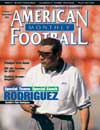AMERICAN FOOTBALL MONTHLY THE #1 RESOURCE FOR FOOTBALL COACHES
Article CategoriesAFM Magazine
|
Play Action for the Big Play© More from this issueThe past three seasons we have experienced much success at Jones Jr. College. In 1998, we were fortunate enough to finish the season 12-0 with a #1 ranking in one national poll. Our no-huddle, one-back offensive attack has averaged 29 points per game in the three seasons we have been together. In the spring of 1997, our staff decided to put in the one-back offense with the objective of spreading the defense. Our offensive philosophy is fairly simple. We want to determine where the defense is going to be, and go somewhere else. We would like to spread the defense, throwing to the perimeter (connecting the dots) by using our 1-step, 3-step, and underneath dropback passing game. If we can successfully spread the defense, then we will be able to run the football and control the tempo of the game. PLAY ACTION PASS A hig....The full article can only be seen by subscribers.
|
|
|||||||
| HOME |
MAGAZINE |
SUBSCRIBE | ONLINE COLUMNISTS | COACHING VIDEOS |
Copyright 2025, AmericanFootballMonthly.com
All Rights Reserved





